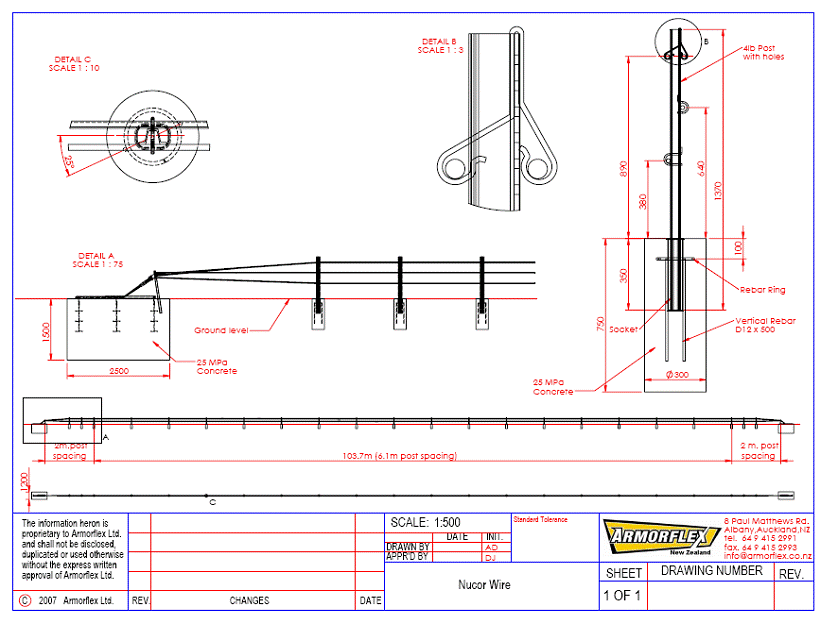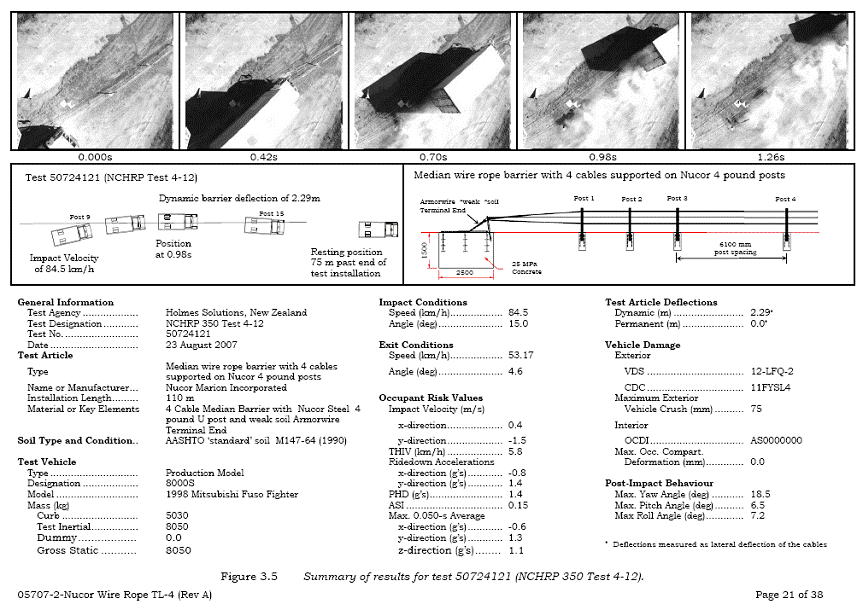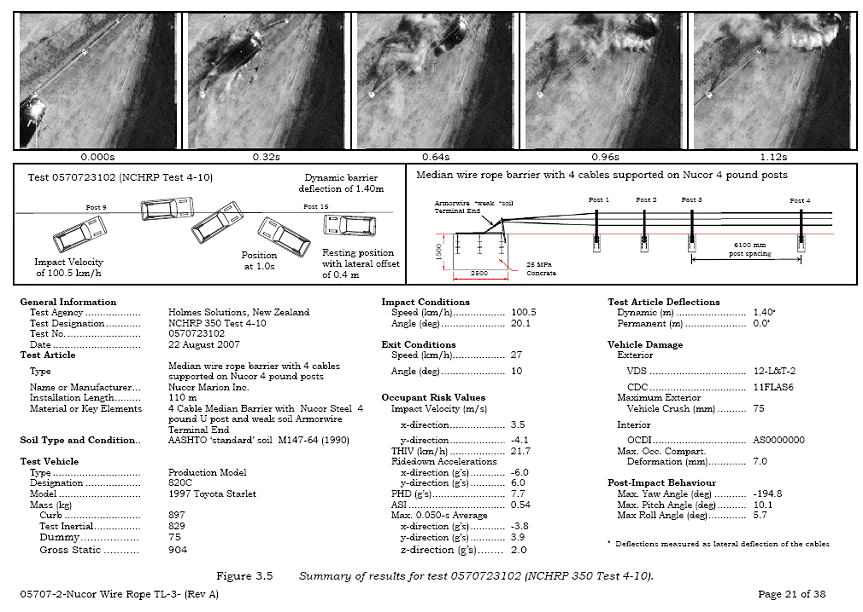Safety Eligibility Letter B-167
HSSD/B-167
Federal Highway Administration |
400 Seventh St., S.W. Washington, D.C. 20590 |
January 24, 2008
In Reply Refer To: HSSD/B-167
Mr. Rick Mauer
Nucor Steel Marion, Inc.
912 Cheney Avenue
Marion, OH 43302
Dear Mr. Mauer:
Thank you for your November 12, 2007, letter requesting the Federal Highway Administration’s (FHWA) acceptance of the four-cable Nucor Wire Rope Barrier System as a Test Level 4 device for use on the National Highway System (NHS). Accompanying your letter were reports of crash testing conducted by Holmes Solutions of Christchurch, New Zealand. You requested that we find this barrier acceptable for use on the NHS under the provisions of National Cooperative Highway Research Program (NCHRP) Report 350 “Recommended Procedures for the Safety Performance Evaluation of Highway Features.”
Introduction and Description
The FHWA guidance on crash testing of roadside safety hardware is contained in a memorandum dated July 25, 1997, titled “INFORMATION: Identifying Acceptable Highway Safety Features.”
The Nucor Wire Rope Barrier System consists of four 19-mm (3/4-inch) wire rope cables attached directly to 4 pound-per-foot Nucor U-post sections. The ropes are attached at heights of 380 mm, 640 mm, and two at 890 mm (15 inch, 25 inch, and 35 inch) above ground level. The lower two cables are attached using locking hook bolts which connect directly to the U-posts. The top two cables are supported by a top clip which engages with the top of the U-post section.
All posts in the Nucor Wire Rope Barrier System are installed directly into plastic sockets that have been cast into 300 mm (12 inch) diameter concrete foundations. The posts are spaced at 6.1 m (20 foot) centers along the length of the barrier. The overall length of the test installation was 103.7 m (340 feet) plus an additional 8 m (26 feet) of Armorwire terminal at either end of the barrier.
The Nucor Wire Rope Barrier System was constructed with the cable fittings and cable adjustment mechanism staggered along the length of the barrier, with two fittings upstream and two downstream from the point of impacts. All of the cable fittings were located midway between the steel line posts.
The 19 mm diameter 3x7 strand “Galvanized 320, lay – RHRL” cables were pre-stretched by 25 percent and tensioned to 25kN (5600 pound-force) at an ambient temperature of 21 Celsius (70 Fahrenheit). The barrier was terminated using the Armorwire Terminal End which was found acceptable in FHWA letter CC-98 dated April 9, 2007.
The U-posts have different dynamic strength characteristics in different orientations. In medians, the posts may be installed in an alternating sequence where each post is rotated 180 degrees from the previous post. It was considered appropriate to orient all posts into the strong axis orientation during the crash tests as it was expected that this orientation makes the posts more prone to failure, thus offering the least assistance in maintaining the cable height. As such, NCHRP Report 350 Test 4-12 was run with the posts oriented with the hollow field towards the test vehicle (i.e. in the strong direction.)
Testing
Full-scale automobile and single-unit truck testing was conducted on the Nucor Wire Rope Barrier System. Successful testing with the 2000P pickup had been conducted on the 3-cable system and this optional test was deemed unnecessary for the validation of the 4-cable barrier. The test details are summarized in the table below, and the test data summary sheets are enclosed for reference.
| NCHRP 350 # | Vehicle Mass | Speed | Angle | Deflection* |
|---|---|---|---|---|
| 4-10 | 904 kg | 100.5 km/hr | 20.1 degrees | 1.40 m |
| 4-12 | 8050 kg | 84.5 km/hr | 15.0 degrees | 2.29 m |
* The “design deflection” of a barrier is that recorded during NCHRP 350 Test 3-11 using the 2000P vehicle. As there has been no test 3-11 on your four-cable TL-4 system we must rely on a TL-3 test showing a deflection of 2.9 m.
Findings
The four-cable Nucor Wire Rope Barrier System described above and shown in the enclosed drawings may be used as either a roadside or median barrier on the NHS under the range of conditions tested when such use is acceptable to the contracting agency.
Although the barrier performed well under ideal test impact conditions with the two test vehicles, the likelihood of passenger car underrides of any cable system may increase as the post spacing increases, particularly when the barrier is installed on non-level or slightly irregular terrain and the cables are not restrained from lifting at each post. Consequently, some transportation agencies have limited post spacing to approximately 6m (20 feet) for cable barriers. The dynamic deflection of the barrier is likely to increase when it is installed along the convex sides of horizontal curves, and when distances between anchorages exceed the 100m (330-foot) test length.
Please note the following standard provisions that apply to the FHWA letters of acceptance:
- This acceptance is limited to the crashworthiness characteristics of the device(s).
- Any changes that may adversely influence the crashworthiness of the device will require a new acceptance letter.
- Should the FHWA discover that the qualification testing was flawed, that in-service performance reveals unacceptable safety problems, or that the device being marketed is significantly different from the version that was crash tested, it reserves the right to modify or revoke its acceptance.
- You will be expected to supply potential users with sufficient information on design and installation requirements to ensure proper performance.
- You will be expected to certify to potential users that the hardware furnished has essentially the same chemistry, mechanical properties, and geometry as that submitted for acceptance, and that they will meet the crashworthiness requirements of the FHWA and the NCHRP Report 350.
- To prevent misunderstanding by others, this letter of acceptance, designated as number B-167 shall not be reproduced except in full. This letter, and the test documentation upon which this letter is based, is public information. All such letters and documentation may be reviewed at our office upon request.
- The four-cable Nucor Wire Rope Barrier System is a patented product and considered proprietary. If proprietary devices are specified by a highway agency for use on Federal-aid projects, except exempt, non-NHS projects, they: (a) must be supplied through competitive bidding with equally suitable unpatented items; (b) the highway agency must certify that they are essential for synchronization with the existing highway facilities or that no equally suitable alternative exists; or (c) they must be used for research or for a distinctive type of construction on relatively short sections of road for experimental purposes. Our regulations concerning proprietary products are contained in Title 23, Code of Federal Regulations, Section 635.411.
- This acceptance letter shall not be construed as authorization or consent by the FHWA to use, manufacture, or sell any patented device for which the applicant is not the patent holder. The acceptance letter is limited to the crashworthiness characteristics of the candidate device, and the FHWA is neither prepared nor required to become involved in issues concerning patent law. Patent issues, if any, are to be resolved by the applicant.
Sincerely yours,
David A. Nicol |




